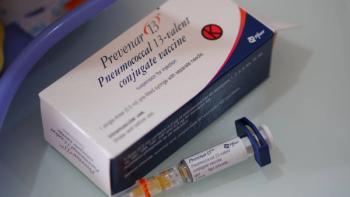
HER2 and HER3 ADCs in Focus: Clinical Pearls for Managing Emerging Toxicities

Corrine Stahura, PharmD; and Sophia Gilardone, PharmD, BCOP, discuss the distinct adverse effect profiles of HER2- and HER3-targeted antibody-drug conjugates—particularly the risk and management of interstitial lung disease—and offer practical guidance based on clinical trial data and treatment protocols.
As antibody-drug conjugates (ADCs) continue to transform the oncology treatment landscape, pharmacists play a vital role in evaluating their unique safety profiles and guiding appropriate management strategies. In an interview with Pharmacy Times®, Corrine Stahura, PharmD, an oncology clinical pharmacist specialist at Penn Medicine, and Sophia Gilardone, PharmD, BCOP, a clinical oncology pharmacy specialist at Penn Medicine, discuss the adverse effects associated with HER2- and HER3-targeted ADCs—particularly trastuzumab deruxtecan (T-DXd; Enhertu; Daiichi Sankyo and AstraZeneca), trastuzumab emtansine (T-DM1; Kadcyla; Genentech), and patritumab deruxtecan (Daiichi Sankyo). They offer practical insights into the identification and management of interstitial lung disease (ILD) and pneumonitis, one of the most serious potential toxicities of these therapies. Drawing on clinical trial data and current treatment guidelines, they provide an evidence-based overview of how pharmacists can support early recognition and risk mitigation in this evolving therapeutic area.
Pharmacy Times: What are the most common AEs associated with HER2-targeting ADCs such as trastuzumab deruxtecan in NSCLC, and how do they compare with traditional chemotherapy?
Corrine Stahura, PharmD: Yeah, so when discussing the adverse effect profile, I think it's best to start by thinking about what an ADC is and how it differs from traditional chemotherapy. ADCs are composed of a monoclonal antibody linked to a cytotoxic drug, or "payload," via a chemical linker. This allows for selective delivery to tumor cells expressing the target antigen, which ideally limits off-target systemic toxicities.
Currently, there are 2 HER2-targeting ADCs on the market: [T-DXd] and [T-DM1]. Both use the HER2-targeting monoclonal antibody trastuzumab, but the attached payloads differ: T-DXd uses deruxtecan, a topoisomerase I inhibitor, whereas T-DM1 uses DM1, a microtubule inhibitor. Because of these different payloads, the adverse effect profiles also differ.
For both ADCs, you may still see the traditional adverse effects associated with trastuzumab, including decreased left ventricular ejection fraction, infusion-related reactions, and headache. However, with the cytotoxic payloads, we see more classic chemotherapy-related adverse effects.
With both T-DXd and T-DM1, we commonly see fatigue, elevated transaminases, and thrombocytopenia. T-DXd tends to have a higher incidence of neutropenia and anemia, and it's considered highly emetogenic. Other notable adverse effects of T-DXd include alopecia and a higher incidence of ILD or pneumonitis. T-DM1, by contrast, is generally better tolerated. It has a low emetogenic risk and may cause some constipation and peripheral neuropathy.
Pharmacy Times: ILD is a known risk with some ADCs—can you describe the incidence and management strategies for ILD in patients receiving HER2 or HER3-targeting ADCs?
Sophia Gilardone, PharmD, BCOP: Looking at the incidence of ILD and pneumonitis, I’ll break it down by HER2- and HER3-targeted products.
As Corrine pointed out, the 2 HER2-targeted ADCs used in non–small cell lung cancer [NSCLC] are T-DXd and T-DM1. With T-DM1, we typically see a low incidence of ILD or pneumonitis. In breast cancer studies, it was less than 1%. In NSCLC case reports, the incidence is less than 5%, mostly grade 1 or 2. T-DM1 is not FDA-approved for NSCLC but is included in treatment guidelines.
For T-DXd, we see a much higher rate of ILD/pneumonitis. In the DESTINY-Lung01 trial, which used a higher dose of 6.4 mg/kg, ILD occurred in up to 26% of patients, with 7% experiencing grade ≥3 events and about 2% experiencing fatal events. In DESTINY-Lung02, the approved dose of 5.4 mg/kg was used. Here, the ILD rate dropped to around 12%, with grade ≥3 ILD in 1% to 2% of patients and no fatal events.
Future studies like DESTINY-Lung03 and DESTINY-Lung04 are also using the lower dose, so we expect similar safety profiles to DESTINY-Lung02. When we pool data across studies, the incidence of ILD ranges from about 10% to 25%, with grade 3 or higher ILD in about 1% to 10%, depending on dose.
For HER3-targeted ADCs, we look at patritumab deruxtecan, which was studied in the HERTHENA-Lung01 trial. It uses the same DXd payload as T-DXd. In this study, the rate of all-grade ILD or pneumonitis was less than 10%, with grade 3 or higher events occurring in about 1% to 2%. One fatal ILD case was reported in HERTHENA-Lung01. Other phase 1 studies have shown similar rates, so in this treatment setting, we see the most ILD with T-DXd, followed by patritumab deruxtecan, and the least with T-DM1.
When it comes to managing ILD across these therapies, the first step is determining whether the patient is truly experiencing ILD or pneumonitis. We need to rule out infections, conduct imaging, obtain blood cultures, and evaluate for other causes such as pulmonary embolism or disease progression—since symptoms can overlap. Imaging is especially helpful, and pulmonary function tests may also be useful. Once ILD is confirmed, we turn to guidance from the drug’s prescribing information or clinical trial protocols.
For T-DXd, the prescribing information offers specific recommendations. If a patient is asymptomatic at grade 1, the drug should be held until the ILD resolves to grade 0. If that happens in 28 days or less, you can resume at the same dose; if it takes more than 28 days, a dose reduction is required. Corticosteroids may be considered—typically prednisone at 0.5 mg/kg/day. For symptomatic ILD at grade 2 or higher, the recommendation is to permanently discontinue the drug. In these cases, corticosteroids should be initiated at 1 mg/kg/day. If there’s no improvement after 5 days, the dose should be increased to 2 mg/kg/day, and intravenous corticosteroids should be considered. For grade 3 or 4 events, hospitalization is recommended, with high-dose IV methylprednisolone followed by a long steroid taper.
In the HERTHENA-Lung01 trial of patritumab deruxtecan, the protocol was similar. For grade 1 ILD, the drug was held until full resolution to grade 0, and the dose decision depended on how long resolution took. Again, corticosteroids could be considered. For grade 2 ILD, treatment was permanently discontinued, and steroids were started at 1 mg/kg/day. If there was no improvement after 5 days, the dose was increased to 2 mg/kg/day or switched to IV. For grade 3 or 4 events, patients were hospitalized and given high-dose IV corticosteroids, again followed by a long taper. While this was a study-specific protocol, we would expect that clinical practice will likely follow a similar approach.
Pharmacy Times: How is the toxicity profile of HER3-directed ADCs, such as patritumab deruxtecan, different from HER2-directed therapies in NSCLC?
Stahura: As Sophia mentioned, patritumab deruxtecan is not currently FDA approved, so all our information comes from the HERTHENA-Lung01 clinical trial. This ADC targets HER3, which differentiates it from HER2-directed agents like T-DXd, although both use the same DXd payload, a topoisomerase I inhibitor.
Because of the shared payload, many adverse effects are similar between T-DXd and patritumab deruxtecan. These include nausea, cytopenias, fatigue, diarrhea, alopecia, and elevated transaminases. However, the incidence of ILD/pneumonitis is lower with patritumab deruxtecan—about 5.3% compared to 12% with T-DXd.
Importantly, no EGFR-related adverse effects—such as acneiform rash, diarrhea, or paronychia—were reported with patritumab deruxtecan, which distinguishes it from EGFR-targeted therapies like amivantamab.
Newsletter
Stay informed on drug updates, treatment guidelines, and pharmacy practice trends—subscribe to Pharmacy Times for weekly clinical insights.


















































































































































































































